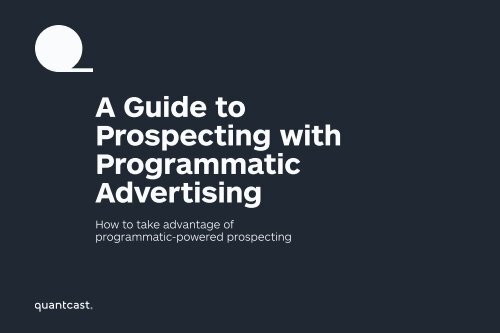A Guide to Prospecting with Programmatic Advertising
Prospecting-With-Programmatic-White-Paper
Prospecting-With-Programmatic-White-Paper
You also want an ePaper? Increase the reach of your titles
YUMPU automatically turns print PDFs into web optimized ePapers that Google loves.
ADVERTISE<br />
A <strong>Guide</strong> <strong>to</strong><br />
<strong>Prospecting</strong> <strong>with</strong><br />
<strong>Programmatic</strong><br />
<strong>Advertising</strong><br />
How <strong>to</strong> take advantage of<br />
programmatic-powered prospecting
ADVERTISE<br />
What’s Inside<br />
4<br />
6<br />
10<br />
14<br />
THE MODERN<br />
MARKETER’S<br />
FUNNEL<br />
PROGRAMMATIC<br />
BUYING<br />
HOW TO<br />
MEASURE<br />
PERFORMANCE<br />
CONCLUSION
ADVERTISE<br />
Introduction<br />
The challenge for marketers over the past hundred years hasn’t changed: <strong>to</strong> find new cus<strong>to</strong>mers<br />
<strong>to</strong> fill the funnel through various advertising channels. It’s now much easier <strong>to</strong> do that in <strong>to</strong>day’s<br />
real-time advertising ecosystem, as marketers are armed <strong>with</strong> new technology and innovation <strong>to</strong><br />
help au<strong>to</strong>mate this process.<br />
The introduction of the ad exchange and programmatic buying—the au<strong>to</strong>mation of buying and<br />
selling online ads—has revolutionized the way marketers scale their companies for growth. Keep<br />
reading <strong>to</strong> understand how <strong>to</strong> take advantage of programmatic-powered prospecting.
ADVERTISE<br />
THE MODERN<br />
MARKETER’S<br />
FUNNEL<br />
Marketers have<br />
<strong>to</strong> incorporate<br />
prospecting <strong>to</strong><br />
scale their<br />
businesses online.
ADVERTISE<br />
THE MODERN<br />
MARKETER’S<br />
FUNNEL<br />
From the onset of traditional advertising,<br />
companies have been following a similar<br />
marketing funnel <strong>to</strong> grow a successful<br />
business. It goes like this: drive awareness<br />
of your business, convince someone <strong>to</strong><br />
consider purchasing and eventually get<br />
them <strong>to</strong> take that action. We call these<br />
phases awareness, consideration and<br />
purchase (or conversion).<br />
In the big picture of direct response display<br />
advertising, however, we often simplify the<br />
marketing funnel <strong>to</strong> focus on upper funnel<br />
and lower funnel efforts or, technically<br />
speaking, prospecting and retargeting.<br />
Both prospecting and retargeting are<br />
important <strong>to</strong> fuel the funnel. Retargeting<br />
is effective since a site visit is one of<br />
the strongest signals <strong>to</strong> show intent of<br />
converting, but it can be limited if no one is<br />
filling the <strong>to</strong>p of the funnel.<br />
The fact is, marketers have <strong>to</strong><br />
incorporate prospecting <strong>to</strong> scale their<br />
businesses online.<br />
© 2016 Quantcast<br />
5
ADVERTISE<br />
PROGRAMMATIC<br />
BUYING<br />
The way we<br />
measure and model<br />
data allows us <strong>to</strong><br />
understand not only<br />
who the audiences<br />
are online, but who’s<br />
actually buying.
ADVERTISE<br />
PROGRAMMATIC<br />
BUYING<br />
<strong>Prospecting</strong> is clearly not a new tactic,<br />
but how we prospect has changed as the<br />
industry has evolved. Originally, marketers<br />
used more broad, segment-based<br />
tactics, leveraging endemic sites, broad<br />
demographics and/or behavioral signals<br />
<strong>to</strong> find prospective cus<strong>to</strong>mers where they<br />
thought they lived. These efforts work well<br />
for brand awareness but resulted in wasted<br />
dollars and impressions for direct response<br />
campaigns, where marketers are looking <strong>to</strong><br />
drive a certain number of conversions.<br />
The way we measure and model data<br />
allows us <strong>to</strong> understand not only who the<br />
audiences are online, but who’s actually<br />
buying—who’s in-market and when.<br />
Many media partners in the space, like<br />
Quantcast, do this by observing the signals<br />
coming from anonymous cookies. And <strong>with</strong><br />
machine learning, they can detect patterns<br />
above and beyond what a single person<br />
could observe and make very educated<br />
guesses, <strong>with</strong>out fac<strong>to</strong>ring in any personally<br />
identifiable information.<br />
Fast-forward <strong>to</strong> <strong>to</strong>day and advertisers have<br />
much more working in their favor. As an<br />
industry we have an unprecedented ability<br />
<strong>to</strong> directly measure individual <strong>to</strong>uchpoints<br />
in marketing and optimize in real time <strong>to</strong><br />
what’s working the best as the campaign is<br />
still running.<br />
We also have an unprecedented number of<br />
<strong>to</strong>uchpoints <strong>to</strong> get in front of people and<br />
have an impact on potential prospects.<br />
Whether you’re talking about an individual<br />
content publisher or social media platforms,<br />
there are many, many places for marketers<br />
<strong>to</strong> reach their audiences online.<br />
© 2016 Quantcast<br />
7
ADVERTISE<br />
PROGRAMMATIC<br />
BUYING<br />
The Rise of Real-time Bidding<br />
With the rise of big data and real-time<br />
bidding (RTB), prospecting is more targeted<br />
and scalable than ever before. RTB, the<br />
method of programmatic buying done in a<br />
real-time auction, lets advertisers buy ads<br />
in the milliseconds from the time someone<br />
enters a site’s web address in a browser<br />
<strong>to</strong> the moment the page loads. It’s a fastmoving<br />
marketplace that’s changing the<br />
face of our industry.<br />
PROGRAMMATIC DIGITAL DISPLAY<br />
AD SPENDING 2016/2017<br />
$21.55<br />
BILLION<br />
67%<br />
In 2016, US programmatic digital display ad<br />
spending will reach $21.55 billion, accounting for<br />
67% of <strong>to</strong>tal display ad spend.<br />
With programmatic buying, targeting is<br />
based on the actual path <strong>to</strong> purchase of an<br />
advertiser’s converters and accounts for<br />
seemingly minute and nonlinear behavior.<br />
It also provides a real-time feedback loop <strong>to</strong><br />
optimize media across the purchase cycle.<br />
$26.78<br />
BILLION<br />
By 2017, it will account for $26.78 billion, or 72%.<br />
Source: eMarketer, 2016<br />
72%<br />
© 2016 Quantcast<br />
8
ADVERTISE<br />
PROGRAMMATIC<br />
BUYING<br />
Ingredients for <strong>Prospecting</strong><br />
<strong>with</strong> <strong>Programmatic</strong><br />
To prospect <strong>with</strong> RTB you’ll need data—a<br />
lot of it. There are countless data sources<br />
that advertisers can use for targeting<br />
consumers, but not all data sources are<br />
created equal. Few data sources are large<br />
enough on their own <strong>to</strong> provide meaningful<br />
targeting insights, so they are often<br />
combined in order <strong>to</strong> reach scale.<br />
A lack of freshness or data integrity can<br />
lead <strong>to</strong> data gaps, data inconsistencies<br />
and flawed targeting models. And finally,<br />
you’ll need an integrated technology that<br />
processes, analyzes and takes action on the<br />
data in real time—or machine learning—<strong>to</strong><br />
feed the real-time bidding process.<br />
You also want freshness, since data can<br />
be out of date even before it reaches an<br />
advertiser. Fresh data gives you an accurate<br />
picture of where your cus<strong>to</strong>mers are in the<br />
purchase cycle. If your average cus<strong>to</strong>mer<br />
takes four days <strong>to</strong> make a purchase on<br />
your website and your cookies are a week<br />
old, you miss the entire purchase cycle<br />
for that cus<strong>to</strong>mer and, as a result, the real<br />
opportunity <strong>to</strong> influence their path<br />
<strong>to</strong> purchase.<br />
© 2016 Quantcast<br />
9
ADVERTISE<br />
HOW TO<br />
MEASURE<br />
PERFORMANCE<br />
Once you know<br />
how your upper<br />
funnel advertising<br />
is performing, it can<br />
help you inform your<br />
full-funnel strategy.
ADVERTISE<br />
HOW TO<br />
MEASURE<br />
PERFORMANCE<br />
The Consumer’s<br />
Path <strong>to</strong> Conversion<br />
No individual path is the same, but there is<br />
a clear point of delineation <strong>to</strong> separate the<br />
data from the upper and lower phase—the<br />
first website visit.<br />
By incorporating the first site visit as a point<br />
of measurement, marketers have the ability<br />
<strong>to</strong> definitively distinguish between ads that<br />
were served as prospecting or retargeting.<br />
We also know how many ads were being<br />
delivered in each phase by every vendor<br />
on a marketing plan and how effective<br />
each partner is at prospecting new visi<strong>to</strong>rs<br />
<strong>to</strong> the site that eventually convert. This<br />
measurement methodology not only<br />
gives insight in<strong>to</strong> the true prospecting<br />
and retargeting, but it also shifts your<br />
partners from a competitive relationship<br />
<strong>to</strong> a collaborative partnership between<br />
the two efforts.<br />
This is how you properly balance your funnel<br />
and create an inclusive partnership between<br />
the two distinct marketing tactics.<br />
© 2016 Quantcast<br />
11
ADVERTISE<br />
HOW TO<br />
MEASURE<br />
PERFORMANCE<br />
Checklist for<br />
Effective <strong>Prospecting</strong><br />
Along <strong>with</strong> the first site visit, there are other<br />
metrics or questions that will help you finetune<br />
campaigns for success. Here are four<br />
important questions <strong>to</strong> ask when evaluating<br />
your prospecting campaigns:<br />
Are you fac<strong>to</strong>ring in site visits? This provides critical insights on how your<br />
cus<strong>to</strong>mers engage along the path <strong>to</strong> conversion. You’ll want <strong>to</strong> take a look at the<br />
entire cus<strong>to</strong>mer journey from the initial site visit <strong>to</strong> the conversion event.<br />
Are you reaching new targets? Expanding your audience is important for driving<br />
incremental conversions <strong>to</strong> ultimately grow your business. You can get this by<br />
measuring the percentage of new people reached.<br />
Are you reaching the right prospects? Measuring how many of the new prospects<br />
reached your site will show you how effective your targeting is.<br />
Are you prospecting qualified leads, or did they actually convert? With the<br />
conversion rate of visi<strong>to</strong>rs <strong>to</strong> converters, you’ll be able <strong>to</strong> measure if your partners<br />
are adequately qualifying your prospects.<br />
© 2016 Quantcast<br />
12
ADVERTISE<br />
HOW TO<br />
MEASURE<br />
PERFORMANCE<br />
<strong>Prospecting</strong> Case Study:<br />
KQED Uses <strong>Prospecting</strong> <strong>to</strong><br />
Generate New Donors<br />
KQED is one of the largest public media<br />
organizations in the United States, providing<br />
television, radio, interactive and education<br />
services <strong>to</strong> Northern California.<br />
In order <strong>to</strong> attract new members and<br />
increase online donations, reducing its<br />
dependence on costly radio and on-air<br />
pledge drives, KQED made a strategic<br />
move in<strong>to</strong> display advertising as a lowcost,<br />
year-round marketing initiative. After<br />
creating a unique audience profile of KQED’s<br />
ideal donor matched against Quantcast’s<br />
real-time view of the web, its targeted ad<br />
delivery yielded impressive results.<br />
Results<br />
• 50% of display donors were new members<br />
<strong>to</strong> KQED’s database, a much higher rate<br />
than any other tactic had driven before.<br />
• Improved response rates from traditional<br />
and radio advertising when supplemented<br />
<strong>with</strong> real-time display.<br />
• 7:1 return on ad spend.<br />
© 2016 Quantcast<br />
13
ADVERTISE<br />
CONCLUSION<br />
<strong>Prospecting</strong> through programmatic buying and real-time bidding can have a huge impact on<br />
scaling your marketing efforts and filling the <strong>to</strong>p of the funnel. Reaching the right people isn’t<br />
enough in <strong>to</strong>day’s media landscape since consumer behaviors shift so quickly; advertisers need<br />
<strong>to</strong> find and target their audience at exactly the right time.<br />
The challenge is in accurately measuring prospecting separately from retargeting and making<br />
educated decisions <strong>to</strong> allocate budget <strong>to</strong> each tactic. Recognizing and understanding the<br />
value of the site visit <strong>to</strong> optimize media tactics is an important step in this process. Quantcast<br />
incorporates the site visit in<strong>to</strong> our comprehensive <strong>Prospecting</strong> Insights report, which includes<br />
several key metrics around the value of the cus<strong>to</strong>mer journey.
ADVERTISE<br />
About Quantcast<br />
Quantcast processes real-time data at the intersection of commerce and culture, providing useful,<br />
actionable insights for brands and publishers. Through Quantcast Measure, we have unlocked the<br />
data generated by millions of digital destinations, helping publishers and crea<strong>to</strong>rs understand and<br />
grow their businesses in ways never before possible. With Quantcast Advertise, adaptive modeling<br />
and intelligent machines are utilized <strong>to</strong> help thousands of marketers around the world find and<br />
interact <strong>with</strong> cus<strong>to</strong>mers anywhere they connect <strong>to</strong> the digital world. Our more than 600 employees<br />
are driven by the potential for big data <strong>to</strong> radically improve everyone’s connected experiences and<br />
transform the way we all make sense of the world.<br />
To learn more about Quantcast’s display<br />
advertising solutions, contact us at<br />
inquiries@quantcast.com.




